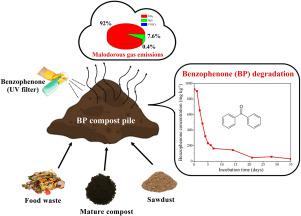Environmental Technology & Innovation ( IF 6.7 ) Pub Date : 2021-01-02 , DOI: 10.1016/j.eti.2020.101351 Chitsan Lin , Nicholas Kiprotich Cheruiyot , Hong-Giang Hoang , Thi-Hieu Le , Huu-Tuan Tran , Xuan-Thanh Bui

|
Benzophenone (BP) and its derivatives are extensively used as ultraviolet filters in modern society and increasingly being released into the environment. Co-composting of food waste with sawdust and mature compost was successfully demonstrated to treat high BP concentration (927 229 mg kg−1), with a removal efficiency of 97% after 35 days of incubation. The highest biodegradation rate of 55 mg kg−1day−1 was observed at the thermophilic stage. The biodegradation followed second-order kinetics, and the half-life of BP was 1.3 days during the co-composting process. Additionally, malodorous gas emissions from the co-composting process were also analyzed. The malodorous compounds, including ammonia (NH3), hydrogen sulfide (H2S), and volatile organic sulfide compounds (VOSCs), peaked at the thermophilic phase. NH3 and H2S were the main components contributing to 92% and 7.6% of the total malodorous concentration (617 ppm). Dimethyl disulfide (28.9 ppb) and dimethyl sulfide (23.5 ppb) concentrations accounted for 58.9% of the total VOSC emitted. The malodorous emissions were positively correlated with temperature, pH, and negative with oxygen content during the co-composting. Sawdust and mature compost enhanced oxygen penetration in the compost mixture and thereby reduced odor emission. These results support that co-composting could be a technically and economically feasible treatment technology for the degradation of BP and can be used to treat other emerging organic pollutants.
中文翻译:

餐厨垃圾与木屑和成熟堆肥共同混合期间的苯甲酮生物降解及恶臭气体排放特性
二苯甲酮(BP)及其衍生物在现代社会中广泛用作紫外线滤光片,并日益释放到环境中。已成功证明餐厨垃圾与木屑和成熟的堆肥共同堆肥可处理高BP浓度(927 孵育35天后,去除效率为 229 mg kg -1),去除效率为97%。在嗜热阶段观察到最高的生物降解速率为55 mg kg -1天-1。生物降解遵循二级动力学,在共同堆肥过程中,BP的半衰期为1.3天。此外,还分析了混合堆肥过程中产生的恶臭气体。包括氨气(NH 3),硫化氢(H 2 S)和挥发性有机硫化物(VOSCs)的恶臭化合物在嗜热相达到峰值。NH 3和H 2S是占总恶臭浓度(617 ppm)的92%和7.6%的主要成分。二甲基二硫(28.9 ppb)和二甲基硫(23.5 ppb)的浓度占排放的VOSC总量的58.9%。在共堆肥过程中,恶臭排放与温度,pH呈正相关,与氧含量呈负相关。木屑和成熟的堆肥增加了氧在堆肥混合物中的渗透,从而减少了气味的散发。这些结果表明,协同堆肥可以作为一种技术和经济上可行的降解BP的处理技术,并可以用于处理其他新兴有机污染物。











































 京公网安备 11010802027423号
京公网安备 11010802027423号